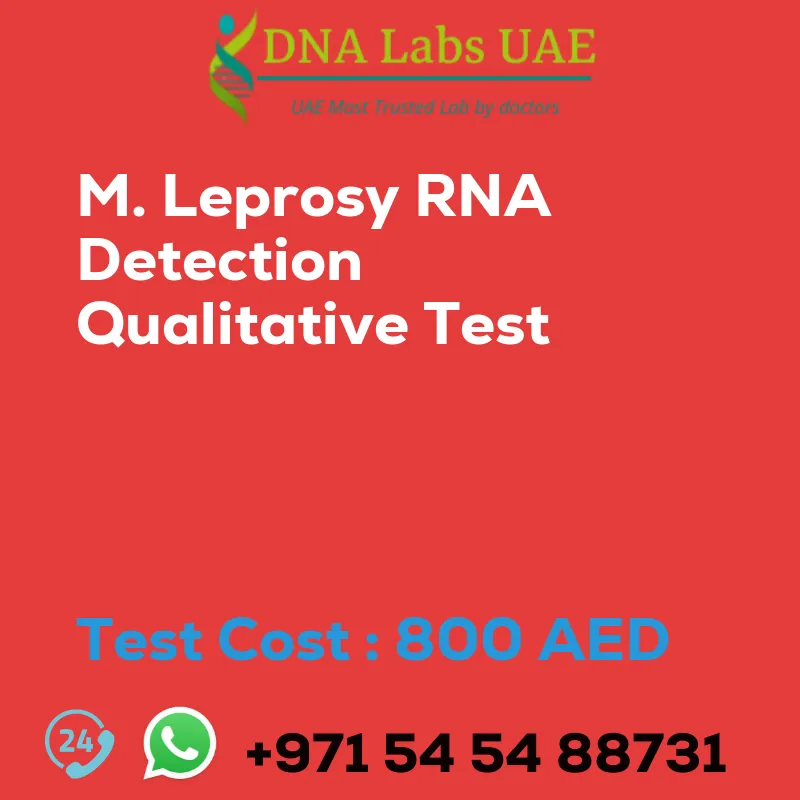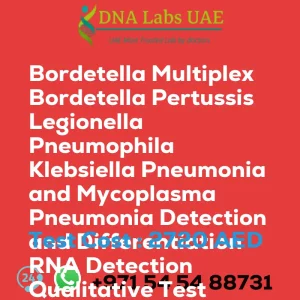M. Leprosy RNA Detection Qualitative Test – DNA Labs UAE
Test Name: M. Leprosy RNA Detection Qualitative Test
Components: RNA Detection Kit
Price: 800.0 AED
Sample Condition: Ear Droppings, Lesion curatings, Biopsy of Patches, Scraps of Nasals mucosa, Urine
Report Delivery: 3rd Working Day via Email (36 hours) or Phone (24 hours)
Method: Real Time PCR
Test Type: Viral
Doctor: Physician
Test Department: Genetics
Pre Test Information: Patients need to sign a Consent document and provide any clinical history related to M. Leprosy
Test Details
The M. leprosy RNA detection qualitative test is a diagnostic test used to detect the presence of Mycobacterium leprae, the bacteria that causes leprosy. This test specifically detects the RNA (ribonucleic acid) of the bacteria.
The test is usually performed on a sample taken from a skin lesion or a nerve biopsy. The sample is collected using a sterile swab or a small piece of tissue. The collected sample is then processed in a laboratory to extract the RNA from the bacteria.
The extracted RNA is then subjected to a molecular technique called reverse transcription polymerase chain reaction (RT-PCR). This technique converts the RNA into DNA (deoxyribonucleic acid) and amplifies specific target sequences of the M. leprae DNA. The amplification allows for the detection of even small amounts of the bacteria’s genetic material.
If the M. leprae RNA is detected in the sample, it indicates an active infection with leprosy. This test is highly sensitive and specific for M. leprae, allowing for accurate diagnosis and early detection of the disease.
The M. leprosy RNA detection qualitative test is particularly useful in cases where other diagnostic methods, such as acid-fast bacilli staining or skin smears, have produced inconclusive or negative results. It can also be used to monitor the effectiveness of treatment and to detect relapses in patients with leprosy.
Overall, this test plays a crucial role in the diagnosis and management of leprosy, helping healthcare professionals provide appropriate treatment and prevent the spread of the disease.
| Test Name | M. Leprosy RNA Detection Qualitative Test |
|---|---|
| Components | |
| Price | 800.0 AED |
| Sample Condition | Ear Droppings, Lesion curatings, Biopsy of Patches, Scraps of Nasals mucosa. urine |
| Report Delivery | 3rd Working Day Email:-36 hours.On phone: 24 hours |
| Method | Real Time PCR |
| Test type | Viral |
| Doctor | Physician |
| Test Department: | Genetics |
| Pre Test Information | Need to sign Consent document and bring any clinical history of patient forM. Leprosy (RNA Detection) QualitativeTest |
| Test Details |
The M. leprosy (RNA detection) qualitative test is a diagnostic test used to detect the presence of Mycobacterium leprae, the bacteria that causes leprosy. This test specifically detects the RNA (ribonucleic acid) of the bacteria. The test is usually performed on a sample taken from a skin lesion or a nerve biopsy. The sample is collected using a sterile swab or a small piece of tissue. The collected sample is then processed in a laboratory to extract the RNA from the bacteria. The extracted RNA is then subjected to a molecular technique called reverse transcription polymerase chain reaction (RT-PCR). This technique converts the RNA into DNA (deoxyribonucleic acid) and amplifies specific target sequences of the M. leprae DNA. The amplification allows for the detection of even small amounts of the bacteria’s genetic material. If the M. leprae RNA is detected in the sample, it indicates an active infection with leprosy. This test is highly sensitive and specific for M. leprae, allowing for accurate diagnosis and early detection of the disease. The M. leprosy (RNA detection) qualitative test is particularly useful in cases where other diagnostic methods, such as acid-fast bacilli staining or skin smears, have produced inconclusive or negative results. It can also be used to monitor the effectiveness of treatment and to detect relapses in patients with leprosy. Overall, this test plays a crucial role in the diagnosis and management of leprosy, helping healthcare professionals provide appropriate treatment and prevent the spread of the disease. |








